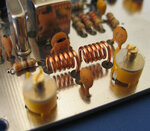Kaspars
Junior Member level 1
Hello,
I was wondering, maybe here are some experts in analog circuit design who could help me?
Here is my circuit:
**broken link removed**
This is receiver circuit for 434MHz OOK/ASK modulation. I colored 4 main questions.
1. The basic interest is in L1 * (*1,5turns), there isn't shown coil diameter and wire diameter. I have calculater from Thomson's equation (f = 1/2*pi*sqrt(LC)) that L = 67nH if I use C = 2pF. Is that correct? Also, can I use smd - 67nH? If I understand correct L1 and C4 is needed for tuning receiver to 434MHz?
2. What do this part?
3. Is this pulse modulator with OP? Maybe someone can explain what does it do and what it is?
4. Never seen befor OP Amp circuit like this, is there something missing? Maybe there is feedback needed? And what it do? All I know, that both these OpAmps amplify the signal.
Thanks for any help.
Best regards,
Kaspars
I was wondering, maybe here are some experts in analog circuit design who could help me?
Here is my circuit:
**broken link removed**
This is receiver circuit for 434MHz OOK/ASK modulation. I colored 4 main questions.
1. The basic interest is in L1 * (*1,5turns), there isn't shown coil diameter and wire diameter. I have calculater from Thomson's equation (f = 1/2*pi*sqrt(LC)) that L = 67nH if I use C = 2pF. Is that correct? Also, can I use smd - 67nH? If I understand correct L1 and C4 is needed for tuning receiver to 434MHz?
2. What do this part?
3. Is this pulse modulator with OP? Maybe someone can explain what does it do and what it is?
4. Never seen befor OP Amp circuit like this, is there something missing? Maybe there is feedback needed? And what it do? All I know, that both these OpAmps amplify the signal.
Thanks for any help.
Best regards,
Kaspars


